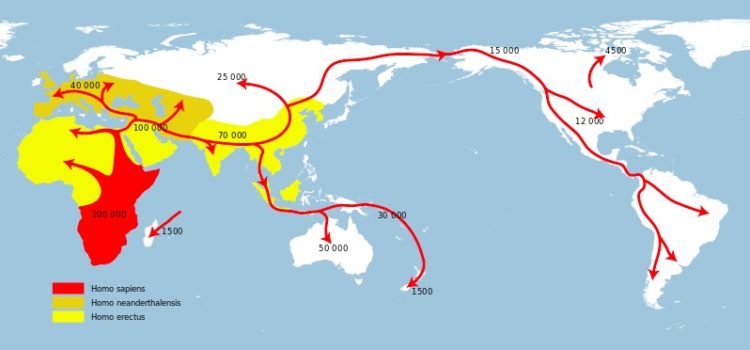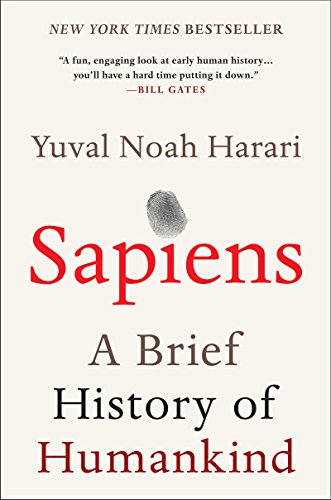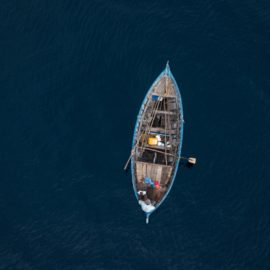

This article is an excerpt from the Shortform summary of "Sapiens: A Brief History of Humankind" by Yuval Noah Harari. Shortform has the world's best summaries of books you should be reading.
Like this article? Sign up for a free trial here .
What happened during the first early human migration? Where did humans start, and where did they end up? How did human migration affect other species?
The first early human migration was the era in which humans figured out how to cross the sea barrier and made it to Australia, 45,000 years ago. The next major early human migration happened 16,000 years ago, when man reached the American continent.
We’ll discuss the progress of the early human migrations and how they caused some of the biggest mass extinctions of all time.
Early Human Migration History
Before the Cognitive Revolution, humans lived solely on the landmass of Afro-Asia and a few surrounding islands. They didn’t alter these environments and ecosystems dramatically. Animals on the African and Asia continents had evolved alongside humans and knew how to avoid them and hold their own.
But as Homo sapiens migrated to other parts of the world, parts wholly unprepared to face the threat of human beings, this would change. We’ll look at the ecological impact of human migration to Australia, America, and then the rest of the world.
Human-Caused Extinction in Australia
Somehow, people of the ancient human migration managed to cross the sea barrier after the Cognitive Revolution. No one’s really sure how, but the best theory is that Sapiens in Indonesia learned how to build boats and managed to reach Australia. Human colonization of Australia is one of the most important events in history, on par with the moon landing. It was here that Sapiens rose to the top of the food chain and became the deadliest species in Earth’s history.
Before the arrival of humans during early human migration, Australia was home to many large animals that sound mythical to modern ears. They included:
- A kangaroo that was six feet tall and weighed 450 pounds
- Seven-foot long snakes
- A marsupial lion
- Flightless birds that were twice as big as ostriches
In just a few thousand years, all of these animals, and many more, were gone. 23 out of the 24 animals weighing 100 or more pounds became extinct.
It wasn’t just Australia. Wherever the early human migration went, humans left a trail of extinction behind. For example, Sapiens only reached New Zealand about 800 years ago. Within a couple hundred years, most of the local megafauna was gone, as was 60% of local bird species. There are numerous examples like this, making Sapiens in particular “look like an ecological serial killer.”
Early Human Migration to America
The disaster in Australia 45,000 years ago was the first mass extinction caused by humans, but it wasn’t the largest. The next major disaster was in America, 16,000 years ago.
Sapiens were the only humans to make it to America. This was the next early human migration. Humans of the Homo sapiens migration came in large numbers from Siberia, when the end of an ice age revealed a land bridge between Siberia and Alaska. Sapiens likely followed large prey like reindeer and mammoths into Alaska. Both were great sources of fat and fur, and hunters thrived.
Non-Genetic Adaptation
This Homo sapiens migration to Alaska was surprising. For a species that evolved in Africa, Sapiens were quick to figure out how to adapt to this cold and inhospitable land. They made snowshoes, used needles to sew layers of furs and skins into thermal clothing, and made new weapons to kill their new prey.
In just a couple thousand years, maybe less, Sapiens had adapted to ecosystems and climates as diverse as those of the eastern U.S., the Mexican desert, the Amazon basin, and the Andean mountain valleys. They did all this adapting without altering their genes.
Shortly after Sapiens arrived, of 47 large animal genera in North America, 34 went extinct. Of 60 large animal genera in South America, 50 went extinct. Thousands of smaller animal species also went extinct.
Consequences of Early Human Migration
The pattern seen in Australia and America (early human migration and the subsequent extinction of many native species) repeated itself all over the world. Between the Cognitive and Agricultural Revolutions, humans caused half of the world’s large beasts to go extinct.
———End of Preview———

Like what you just read? Read the rest of the world's best summary of "Sapiens" at Shortform . Learn the book's critical concepts in 20 minutes or less .
Here's what you'll find in our full Sapiens summary :
- How Sapiens outlived and outlasted the 8+ other human-like species on Earth
- The 3 critical revolutions in human existence that led to our domination of the planet
- How much of what powers our world today is really just a shared mass delusion
- What the future of humanity might look like






